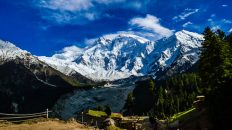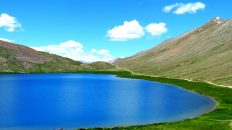K2, at 8,611 metres (28,251 ft) above sea level, is the second highest mountain in the world, after Mount Everest at 8,848 metres (29,029 ft). It is located on the China–Pakistan border between Baltistan in the Gilgit-Baltistan region of northern Pakistan, and the Taxkorgan Tajik Autonomous County of Xinjiang, China.[3] K2 is the highest point of the Karakoram range and the highest point in both Pakistan and Xinjiang.
K2 lies in the northwestern Karakoram Range. It is located in the Baltistan region of Gilgit–Baltistan, Pakistan, and the Taxkorgan Tajik Autonomous County of Xinjiang, China.[a] The Tarim sedimentary basin borders the range on the north and the Lesser Himalayas on the south. Melt waters from vast glaciers, such as those south and east of K2, feed agriculture in the valleys and contribute significantly to the regional fresh-water supply.
Climbing routes and difficulties
There are a number of routes on K2, of somewhat different character, but they all share some key difficulties, the first being the extremely high altitude and resulting lack of oxygen: there is only one-third as much oxygen available to a climber on the summit of K2 as there is at sea level. The second is the propensity of the mountain to experience extreme storms of several days duration, which have resulted in many of the deaths on the peak. The third is the steep, exposed, and committing nature of all routes on the mountain, which makes retreat more difficult, especially during a storm. Despite many attempts there have been no successful winter ascents. All major climbing routes lie on the Pakistani side, which is also where base camp is located.
The climb
The Pakistan side
The Abruzzi Spur (South East Ridge)
First climbed by Italians in 1954, this is the closest to a “normal” route on K2, but is still very difficult and statistically the most dangerous. The route starts with approximately 1000 m of climbing on loose scree (bring a helmet!) with significant danger of rocks falling from Camp 1 and above.
C1 6050 m (20000 ft)
C1 is exposed but relatively secure, with little or no history of avalanche danger. The climb to C2 includes a 50-meter off-width crack called House’s Chimney which is currently a spider’s web of old ropes.
C2 6700 m (22000 ft)
C2 is sheltered by a large rock, but can get extremely windy and cold. C2 to C3 is the most technical section of the climb, with approximately 400 meters of vertical and near-vertical climbing on mixed rock and ice in a region known as the “Black Pyramid.”
C3 7200 m (23500 ft)
At the top of the Black Pyramid, C3 is traditionally placed on the Shoulder. Although this is more horizontal terrain (approx. 30 degree snow fields), it is prone to avalanche danger and extremely high winds funneling between K2 and Broad Peak. Consider stashing camp equipment just below in the Black Pyramid; many climbers are forced to descend when they discover that their C3 has been destroyed by avalanches. C3 to C4 is a long snow slog up the Shoulder, typically accomplished without fixed lines.
The primary danger in this area is the collapse of large sections of the Shoulder (you can sometimes feel the slope settling under you). Fixed lines are not going to protect you from the huge avalanches that happen when a section of the Shoulder rips, so you’re better off travelling fast and light.
C4 7600 m (25000 ft)
C4, at anywhere from 7600 to 7900 meters on the Shoulder, is still a solid 16-22 hours from the summit, so you should start brewing immediately (don’t spend too much energy building a platform, you won’t have time to sleep anyhow).
Summit 8611 m (28250ft)
Most climbers leave between 10 p.m and 1 a.m. for the summit. Consider bringing a thin line (4-5mm) for the Bottleneck, a 100-meter narrow couloir at 8300 meters that is 80-90 degrees. If it is windswept and cold, the ice in this couloir can create extremely challenging, sustained climbing. At least 10 of the climbers who have died on K2 lost their lives in the Bottleneck.
North East Ridge.
First climbed by Rick Ridgeway, John Roskelly, Lou Reichardt, and Jim Wickwire in 1978, this is a long snowy rib starting at the head of the Godwin-Austen Glacier that leads to a difficult, extremely corniced ridge. The ridge is followed to 7,900 meters, where the route then traverses the East Face and finishes on the Abruzzi Spur.
South-South-East Spur
First climbed by a Basque team in 1994, this variation to the Abruzzi Spur is possible the “safest” way up the mountain. The Spur joins the Abruzzi route at C3 on the Shoulder.
South West Pillar (The “Magic Line”)
Dubbed “The Magic Line” in a widely publicized pre-expedition tour, Reinhold Messner took one look at this route in 1979, called it “suicidal”, and switched to the normal Abruzzi route. It was climbed in 1986 by a Polish team, and is still the hallmark of “suicidal” excellence, with exceptionally hard, steep sections of icy rock at very high altitudes.
South Face (The “Polish Route”)
If you are not afraid of avalanches, this is the route. With extreme serac avalanche danger in the lower section, a curved gully (the “Hockey Stick”) that crosses prime snow slab terrain, and constant spindrift avalanches in the upper portion of the route, this route is not for everyone.
West Ridge
Starting from a Base Camp on the distant Negrotto Glacier, this route gains the ridge crest at about 5800 meters. The primary challenge is route finding through chaotic bands of rock and snowfields, and setting fixed lines at high altitudes while traversing the West Face.
The Chinese side
The Chinese side of the mountain is the less frequently visited side, and there are usually no climbers on this side of the mountain. Historically, teams on this side of the mountain have either been very large, or loose-knit groups of smaller international teams working together. There are only 2 established routes on the Chinese side:
North Ridge
First climbed in 1982 by a large Japanese team, this route requires approximately 5,000 meters of fixed line. It is perhaps the most compelling route in the Himalayas – a vast, sweeping ridge running from 17,000 feet to the summit. Due to obstacles at 8,450 meters, the route currently deviates from the ridge at about 7800 meters and traverses across the north face to the North East Ridge.
With the need for so much fixed line and the tendency towards large teams, one primary consideration is the limited camp space at C1 and C4. C1 is typically placed inside a bergschrund (a deep crack in the snow slope) to the right of the ridge. It is frequently subject to heavy spindrift avalanches, and must be constantly maintained. C4 is sometimes called the “Eagle’s Nest”, and has space for only 2 two-person tents. The climbing on the route is primarily ice. It is sustained, but without great technical difficulty and at a moderate angle.
North West Face
First climbed by a Japanese team in 1990, this is a “king traverse” route. Starting from the K2 Glacier, the route climbs to the North West Ridge, then diagonals across the chaotic rock and snow fields of the North West Face to join the North Ridge route to the summit.
Mountains in Pakistan over 8000+ meters:
World Rank |
Rank (Pakistan) |
Name |
Height |
|---|---|---|---|
| 2 | 1 | K2 | 8611 |
| 9 | 2 | Nanga Parbat | 8126 |
| 11 | 3 | Gasherbrum I (K5) | 8080 |
| 12 | 4 | Broad Peak | 8051 |
| 13 | 5 | Gasherbrum II (K4) | 8035 |






